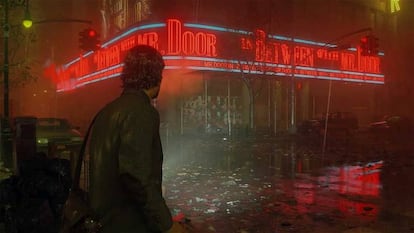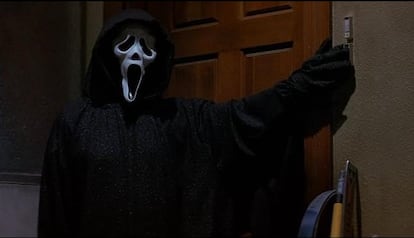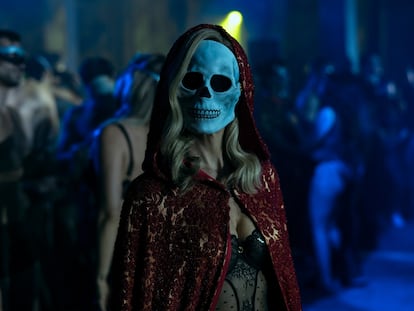The horror paradox: Why scary movies can be good for your mental health
According to experts, getting spooked recreationally can help you manage stress and anxiety. The consumption of this genre of cinema has skyrocketed after the pandemic

Fear clung to his gut and, at night, it emerged in the form of nightmares.
That’s why little Mathias tried not to watch those movies: he changed the channel, closed his eyes, turned off the TV. But everything changed when he reached adolescence. By chance, he stumbled upon a miniseries called Apocalypse, about a dystopian future after a pandemic. Then, he read the book that the series was based on. It was by a certain Stephen King. It was terror at first sight.
Mathias swept the library, then the video store. Scream, Halloween, Friday the 13th, The Texas Chainsaw Massacre... he still had nightmares, but he didn’t care anymore. He read and watched everything. It was the kind of adolescent obsession that ends up marking a life.
Mathias Clasen is 45-years-old today. He’s a professor of literature who specializes in the horror genre. He’s the author of the book Why Horror Seduces and director of the Recreational Fear Lab at the University of Aarhus, in Denmark.
Clasen has a theory about his sudden teenage conversion. “It’s a very common trajectory,” he explains, in a phone interview with EL PAÍS. “More than 95% of parents say their children find pleasure in some type of recreational fear. In young children, it’s mainly driven by risky behaviors: physical play, climbing a tree too high, or riding a bike too fast. But when they grow up, it becomes a more controlled fear. They look for it in movies, books and video games.”
This interest begins in the early-teens and peaks before one reaches the age of 20. It then gradually declines with age… but it doesn’t disappear completely. Human beings feel a strange fascination with fear. We pay to be scared at amusement parks. We go to the movies or pick up a console to scream a little. We seek experiences that expose ourselves to unpleasant sensations, which push us to the limit. This is all part of what’s known as the “terror paradox” — a mystery that the fields of psychology and neuroscience have been theorizing about for years.
“The short answer is that humans are biologically designed to find pleasure by playing with fear, because it’s a learning mechanism,” Clasen reflects. “Recreational fear is a safe space in which we can practice [regulating our emotions].” Consuming these cultural products could provide an adaptive advantage, by preparing viewers to face new scenarios in life
Clasen had the opportunity to test this theory when the world became a horror movie, similar to the one he was obsessed with as a teenager. With the population locked down at home due to the pandemic, his team began asking volunteers how they were coping with the situation. Subsequently, his theories were verified. “People who’d seen a lot of horror movies, (especially related to viruses and pandemics) reported greater psychological resilience to stress [than those who hadn’t],” he confirms. “These films proved to be a tool to regulate emotions.”

The lists of most-viewed films during those months also validated his idea. You might have expected people to take refuge in gentle comedies, but this wasn’t the case. Contagion (2011) — a Steven Soderbergh production about a deadly virus that devastates the planet — became the second-most downloaded film on iTunes during the pandemic, despite having been released 10 years earlier. The consumption of horror films increased exponentially, reaching figures that have remained stable since then. In 2014, they accounted for 2.69% of the annual box office, but this percentage jumped to 12.75% by 2021, according to The Numbers, a film industry data platform.
“Horror movies have never been as popular as they’ve been in the last three years,” Clasen confirms. “But I still don’t have a clear idea as to why.” It may be that, in times of uncertainty, people seek explanations in fiction, inoculating themselves with a dose of tolerable terror that prepares them for fear in real life. “It’s a way of getting vaccinated,” the expert shrugs. “It prepares us, in a safe environment, to deal with stress and anxiety. And with the war, the pandemic, the crises… we have a lot of that in our reality lately.”
Jorge Casanueva is a film critic who specializes in horror. He manages the Horror Losers online community. He agrees that the genre is thriving commercially, although he frames this success within historical stability. “The topics change to reflect the fears of society… but the success [of the horror film industry as a whole], even with its ups and downs, does not,” he tells EL PAÍS by phone. “This is an infinite genre. It’s a constant, because it’s in our nature to watch these types of films.”
Casanueva has a more practical theory for why horror is so appealing. “It’s fun,” he summarizes. “I think the viewer is looking — on a physiological level — for an adrenaline rush. Having a bad time, sometimes, is simply entertaining, especially if you do it with friends in a movie theater.” The context in which we consume these films is important. They’re not usually watched alone, but in groups… for obvious reasons. A 2021 study published in the scientific journal PLOS One showed that well-matched couples felt much less stress watching a scary movie with their partner than when doing so alone. Terror is less terrifying when it’s shared.
Detecting murderers in real life
A recent study from the University of Toronto — Surfing Uncertainty with Screams — analyzes human attraction to horror movies from the framework of predictive perception. This theory means that our internal model of the world isn’t necessarily based on reality, but is rather an interpretation of it. Our brain analyzes what’s happening and fills in the information gaps with what it believes is happening. That’s why we can read a word perfectly, even if it’s missing letters. Or interpret the image of a puzzle, even if it doesn’t have all the pieces. But to do this, one requires prior information, such as having read that word before, or having seen a landscape similar to the one in the puzzle. “That’s why horror movies are perfect, because they give us information about contexts we’ve never been in,” explains Mark Miller, the lead author of the study, in a phone interview with EL PAÍS. He’s a researcher in the Department of Psychology at the University of Toronto.
These films are based on familiar scenarios and situations. They reproduce stereotypes and clichés. They leave clues about what’s going to happen, with elements such as music. But at the same time, one of the main mechanisms of horror is the element of surprise, which usually occurs in an unexpected final twist, or — in its most distilled and basic form — in the sudden scare. “In a way, we can say that horror movies are designed for our system: they have a balance between the predictable and the unexpected,” the author reflects. “If we think of man as a machine that wants to collect information to minimize surprises, this type of training is perfect.”

So, for example, watching “true crime” can help detect the behavior of a murderer or a rapist… very valuable knowledge in real life. This would explain why these documentaries are more successful among women, who make up 70% of the audience, according to a study by Social Psychological and Personality Science. They’re overwhelmingly the potential victims of these crimes, so they’re the ones who can best benefit from what’s been learned.
The success of giallo — a subgenre that originates in Italian cinema, in which clues to the identity of the murderer are given during the movie and revealed in the final scene (with examples ranging from Scream to Murder, She Wrote) — also fits into the framework of predictive processing. These films actively toy with the viewer, while helping them solve the mystery before the protagonist does. “And the most important thing isn’t only our reaction,” Dr. Miller explains. “We see how the characters react… and then we comment on it. If you notice, when you watch a scary movie, you’re always comparing what you would do with what the character does. You say, ‘don’t go down to the basement,’ ‘grab the bat,’ or ‘don’t get separated!’ This is because you’re adjusting your predictive model for how things work in uncertain scenarios, comparing possible [real-life] behaviors. So, you’re harvesting information and [improving] results.”
This mechanism would work with all types of films, but it’s in the horror genre where it becomes most important. Firstly, because it places us in improbable scenarios: the life of any person swings between comedy, drama, or porn, depending on the context, but it will rarely go through horror scenarios. You’re more likely to fall in love with a co-worker than to encounter a killer clown hiding in a sewer. Furthermore, Miller points out, “we’re evolutionarily predisposed to be attracted to negative stimuli a little more than positive [stimuli]. It’s less important to notice someone [winking] at you than to detect a tiger’s tail moving behind the tree.”
The example of the tiger, the expert points out, isn’t coincidental. “When we try to represent our fears, we appeal to our evolutionary heritage. We use symbols that produce a visceral reaction in us… a reaction that has been encoded in our instincts for millennia.” Fictional villains — such as Jason Voorhees, Freddy Krueger, Michael Myers, or Ghostface — lurk in the shadows like feline predators, using sharp weapons, as if they were claws or teeth. They’re the pop culture update of atavistic fears — symbols that man learned to fear thousands of years ago.

“If these movies were about effective killing, all the villains would carry automatic rifles,” Miller’s study notes. “However, they [principally] have to do with fear. A chainsaw isn’t a very effective method for killing a group of teenagers… it’s heavy, noisy and can run out of fuel. However, it instills fear, because its characteristics (sharp teeth and a loud roar) mimic those of predatory mammals.”
There are other aspects in which the genre has evolved. “Currently, there’s an average of 10 scares per film,” Clasen points out, “which means we have a scare every 10 minutes or so.” It’s the optimal number, as if it were a mathematical formula. But it wasn’t always like this: in the 1960s, there were only two or three shocks per film. “Then, it went up. And it’s been stable ever since,” he explains. All this can be verified on Where’s the Jump? This scary movie repository points out the exact second where there’s a scare. In the long list of the films that have abused this resource the most, there are hardly any productions from the 20th century.
In horror, the maxim of “the more the better” doesn’t work. “We demonstrated it a few years ago in a study,” Clasen recalls. “We thought there would be a linear relationship, but no, the curve is rainbow-shaped. There’s a moment — which we have called the optimal point of fear — in which enjoyment begins to decline.” That’s when fear stops being fun and starts being unpleasant. The expert explains that this is the reason why horror video games haven’t completely succeeded in the new virtual reality: they’re simply too intense. Titles such as Resident Evil VII — which could be enjoyed without problems on a TV — require special courage to be played with a VR headset. Perhaps that’s why the new bets in the sector — such as the recently-released Alan Wake 2 — have left virtual reality aside, to be released only in the classic format.
Fear — in the world of video games — is a particularly fertile genre. It works very well, because it requires the player to take action… they cannot simply close their eyes in the face of a frightening scene. You cannot simply say, “I would do that instead.” You must do it, or your character will die. This generates more concern than a movie, as the experience is more immersive. Still, there comes a point where it can be too much.
In any case, video games are the latest evolution of a tool that has always been there: stories designed to warn about the dangers of real life. And this ranges from children’s fables — such as Little Red Riding Hood — to folkloric myths that were told around the bonfire, or depicted in cave paintings, which reflected terrifying beasts.
“Terror has always existed, since humans have had the ability to create imaginary worlds,” Clasen concludes. And it will continue to exist, he adds, unless something truly terrifying happens.
Sign up for our weekly newsletter to get more English-language news coverage from EL PAÍS USA Edition
Tu suscripción se está usando en otro dispositivo
¿Quieres añadir otro usuario a tu suscripción?
Si continúas leyendo en este dispositivo, no se podrá leer en el otro.
FlechaTu suscripción se está usando en otro dispositivo y solo puedes acceder a EL PAÍS desde un dispositivo a la vez.
Si quieres compartir tu cuenta, cambia tu suscripción a la modalidad Premium, así podrás añadir otro usuario. Cada uno accederá con su propia cuenta de email, lo que os permitirá personalizar vuestra experiencia en EL PAÍS.
¿Tienes una suscripción de empresa? Accede aquí para contratar más cuentas.
En el caso de no saber quién está usando tu cuenta, te recomendamos cambiar tu contraseña aquí.
Si decides continuar compartiendo tu cuenta, este mensaje se mostrará en tu dispositivo y en el de la otra persona que está usando tu cuenta de forma indefinida, afectando a tu experiencia de lectura. Puedes consultar aquí los términos y condiciones de la suscripción digital.
More information
Archived In
Últimas noticias
There is as much life left to discover on planet Earth as that which is already known
Dozens presumed dead, around 100 injured in fire at Swiss Alps bar during New Year’s celebration
Is porn for women different from conventional porn? We spoke to those who make it
Cartagena de Indias is sinking: What can the city do to mitigate it?
Most viewed
- Sinaloa Cartel war is taking its toll on Los Chapitos
- Reinhard Genzel, Nobel laureate in physics: ‘One-minute videos will never give you the truth’
- Oona Chaplin: ‘I told James Cameron that I was living in a treehouse and starting a permaculture project with a friend’
- David King, chemist: ‘There are scientists studying how to cool the planet; nobody should stop these experiments from happening’
- Why the price of coffee has skyrocketed: from Brazilian plantations to specialty coffee houses











































